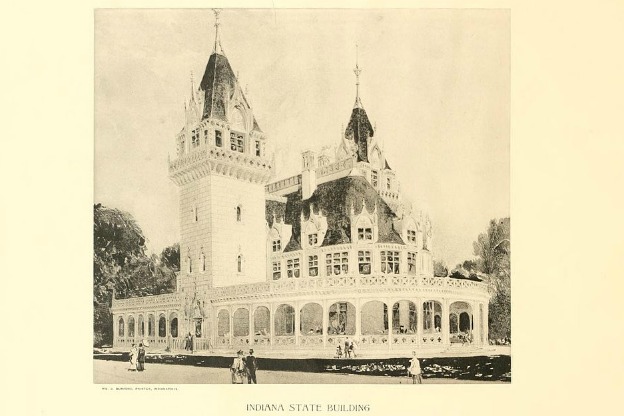The 1893 Chicago World’s Fair commemorated the 400th anniversary of Columbus’s expedition; the beautiful White City hosted an unprecedented celebration.
All of the nation’s forty-four states and territories exhibited at the fair; most of them sponsored a building which “served as [a] clubhouse[] for their citizens and as display areas for art, educational, historical, and natural resource exhibits.”
The Indiana of the1890s had much to celebrate: it was a strong manufacturing and agricultural presence in the nation, and the home to a number of nationally important politicians (including recent president Benjamin Harrison) and famous writers (among them Booth Tarkington, Lew Wallace, and James Whitcomb Riley).
In 1890, Governor Alvin Hovey nominated Elijah B. Martindale of Indianapolis and Thomas Garvin of Evansville to be the state’s world’s fair commissioners. These men took the lead in urging their fellow citizens to mount a building and exhibits worthy of the Hoosier state.
In 1891, the General Assembly appointed a state commission (among its members nationally known suffragist May Wright Sewall and manufacturer Clement Studebaker) tasked with implementing the project. The commissioners ran afoul of the legislature and the press, however, when they chose a design for the Indiana building from Chicago architect Henry Ives Cobb (not so coincidentally, the designer of Studebaker’s home in South Bend). The Indiana building—which cost $64,000 to construct—would eventually go on to win an award for architectural excellence.
The commissioners worked hard over the next two years to gather and organize exhibits. Schoolchildren were given special lessons on “Exhibition Days” and they and their teachers contributed to a “Penny Fund,” eventually raising over $5,000 to help pay for Indiana’s exhibits. The statehouse was used as one of the gathering sites for exhibits, and it filled up “with blocks of stone and coal and samples of corn, wheat, rye, and other grains.”
When the exposition opened in May, Indiana newspapers reported daily on the fair and offered readers details on their state’s exhibits. Chicago hotels placed advertisements in Indianapolis papers; railroads offered additional trains to carry Hoosier sightseers to the exposition. Fair organizers designated September 27, 1893, as “Indiana Day.” In response, as many as 100,000 Hoosiers came to the fair on that day alone.
In the Manufactures and Liberal Arts Building, they saw “washing machines from Evansville, plate glass from Kokomo, refrigerators from Michigan City, oil tanks from Fort Wayne, and blankets from Seymour.” Indiana was especially prominent in the Agriculture Building, where there were “large pyramids of glass jars filled with samples of corn, wheat, rye, and other cereal grains. There was also a twenty-five-foot-high pyramid of corn in stalk.”
Visitors from England, Germany, and Italy were so impressed with the quality of Indiana’s corn that they purchased samples to ship home. Indiana resources and machinery were also featured in the Forestry, Dairy, Machinery, Transportation, Horticulture, Women’s, Art, and Mines and Mining Buildings.
Nearly one in seven Hoosiers attended the fair during its run. Indiana citizens took pride not only in their state’s building and the wide variety of Indiana products displayed throughout many other buildings, but in that fact that Indiana natural gas and oil had helped power the fair and that Indiana limestone and wood had been used in some of the buildings. In turn, the fair influenced Hoosiers; many experienced the practical uses of electricity for the first time, learned about the peoples and cultures of other countries, and viewed, in the beautiful White City, a future of clean, planned urban living.
A Moment of Indiana History is a production of WFIU Public Radio in partnership with the Indiana Public Broadcasting Stations. Research support comes from Indiana Magazine of History published by the Indiana University Department of History.
IMH Source Article: Frank A. Cassell and Marguerite E. Cassell, “Pride, Profits, and Politics: Indiana and the Columbian Exposition of 1893,” Indiana Magazine of History 80, no. 2 (June 1984): 93-121.























